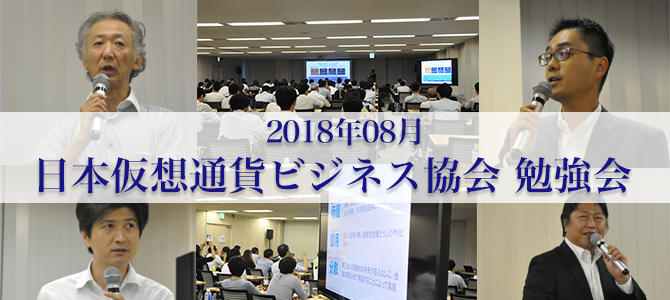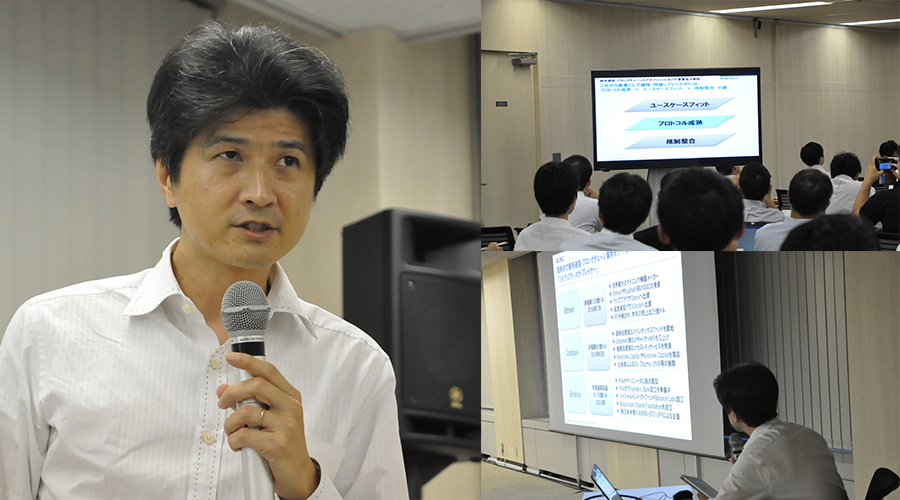The latest attack trend and how to minimize the damage

Curriculum and overview
- Date and time:Wednesday, August 29, 2018 17: 00 – 19: 10
- Place:Fukurasia Tokyo Station Meeting Room H (5th Floor)
- Part 1 “Latest attack trends and methods for minimizing damage”
- Part 2 “Countermeasures against money laundering required for virtual currency exchange”
- Part 3 “Overview of technology trend over encryption currency / block chain”
Part 1 “Latest attack trends and methods for minimizing damage”
I mentioned two new threats, SIM hijacking and malware actually used for attack.
Especially in the case of SIM hijacking, smartphones are used for 2-step verification, but attacks of hijacking SIM used there are appearing in the United States.
It is dangerous to think that it is okay because there is multifactor authentication.
Next I would like to mention that I can not find the malware used for the attack.
So, we briefly summarized the policy on what kind of countermeasures should be considered based on such things, so I would like to introduce them.
As a recent threat, I tried to summarize what is related to the virtual currency. The first is to tamper with the transaction information of the block chain itself.
Then attack one of the nodes to infect malware and put a virus in one client dealing in the virtual currency and do illegal transactions.
Another thing is that there are cases like attacking virtual currency exchanges.
It is very difficult to tamper with the transaction information itself in the first block chain.
The block chain itself is a huge P2P network to say the extreme. When encrypting and delivering transaction information in it, when an error occurs, it corrects the error by a method like a majority decision, so to alter the transaction information itself, it is necessary to tamper with 51% of all nodes there is.
Since there are many nodes in the block chain of bit coins, it is impossible to alter the entire transaction information by tampering 51% of them.
Part 2 “Countermeasures against money laundering required for virtual currency exchange”
Today’s agenda, the report of the report “Interim report of virtual currency exchangers etc. inspection / monitoring summary” was announced from the Financial Services Agency in August, so I will briefly introduce it.
Then I will explain the fundamental concept of anti-money laundering and the flow of AML work and let me briefly explain the functions required for AML system based on that.
I will tell you a little about the case study of suspicious transactions in virtual currency transactions and I will talk about further advanced AML system.
I will excerpt the current status of inspection and monitoring announced by the Financial Services Agency in August.
Although it is a copy of the documents of the Financial Services Agency, there are three lines of defense of the business department, the risk and compliance division and the internal audit department at the 1st and 2nd lines to the 3rd line, We are not doing the maintenance of the internal management system according to the risk after evaluating the risk of sharing of funds with antispermanance, “and it is the present condition that advanced countermeasures are required for countermeasures against manor.
Next, the basic concept of anti-money laundering, we list three main things that support the business, one is customer management, the second and third are management of transactions.
Of course, it is an inseparable part because the customer makes a transaction, but here we divide it by dealing with customers.
Regarding customer management, it is called Know Your Customer and it is called KYC work, but it is also called CDD as Customer Due Diligence.
Although we manage transactions, we list two in the filtering and monitoring of transactions, and the filtering of transactions judges on the spot whether the transaction is through or not through the transaction when the transaction is requested from the customer, Judge beforehand, but it becomes a filtering business of the transaction.
The transaction monitoring business is a business that links several transactions by batch processing such as daily, weekly, monthly, etc. after the execution of the transaction, analyzes the transaction, and conducts transactions suspected of money laundering and terrorist financing It will be a task to show off.
There is a risk-based approach as a concept that follows these three tasks.
It was announced by the Financial Services Agency in February this year and it is said that it is the minimum standard that such a way of thinking naturally carries out …
Part 3 “Overview of technology trend over encryption currency / block chain”
Coinbase / Bitmain / Binance listed here are three mega players who can say that they are leading the industry right now.
Mining equipment manufacturers and exchanges are lining up, but I think that such players will come out one after another from now on, and I think players will come out in forms other than mining and exchange .
The important thing for doing encryption currency and block chain adaptation is what is it to use encryption currency or block chain?
Three keywords are cited as a purpose of utilization, but it is Internet of value, trast stress, non-centralized power.
When assuming to use for such purpose, encryption currency and block chain as a point of trying to take off or leap in industry, maturation of protocols, fitting of use cases, consistency with regulation I think that is where.
First of all, it is an overview of the main block chain protocol, but in the first place, I think that speaking the word block chapter vaguely with a general noun is at its limit.
There are so many platforms in the block chain, and we organized it in two axes from the viewpoints of transactions publicly on the vertical and horizontal axes, whether the transaction is public or flexible, and the flexibility of contract creation. Since time is limited, today I will focus on public matters of this matrix.
Although there is a direction to compare the current state of the block chain to the Internet of the 1990s, I think that the Internet has reached the maturity after chaos in the 1990s.
Maturity of the protocol that occurred at that time became available for internet banking and mobile banking in the process of increasing throughput, improving the accuracy of privacy, governance, security, standards progresses.
We can apply the five blocks seen by the maturity of the Internet to the block chain, and I would like to organize it with blocks called throughput, privacy, governance, security, and standards. I believe that the current block chain also has five problems that must be solved in the same way as in the Internet in the 1990’s, and I would like to see through throughput, privacy, governance, security and finally in the order of standard I think.
The first thing to mention is transaction and processing performance issues.
In the block chain, it is structured to store transactions that have flowed in the network in the bucket, and since the size of the block or bucket is decided at that time, there arises a problem that it is not decided that a large amount of transactions will arrive. I think whether there is a duplication of duplication and a dilemma of dispersion when trying to solve this.
A duplication dilemma means that block chains have duplicate copies of ledgers and then do not rely on a player like a certain rich player but have a mechanism to verify transactions with everyone who joins the network As shown in Fig.
Everyone verifies with the same ledger copy, so simply increasing the number of participants will not increase the performance of the verification.
Distributed dilemma means that if you want to process large volumes of transactions, you may want to increase the size of the bucket itself, but as soon as power concentrates on only the specific strength that distinguishes a large bucket However, at the same time, the risk of hacking also increases, so it is not preferable. These two are the scalability issues of transactions.
For example, in the case of distributed databases, throughput performance improves as nodes are increased, but since each participant verifies the entire data of the block chain in the block chain, even if the number of nodes is increased, the throughput Unfortunately performance is not improved …
STUDY
『最新の攻撃動向と被害の最小化方法』
『仮想通貨交換業者に求められるマネーロンダリング対策』
『暗号通貨・ブロックチェーンを巡る技術トレンド概観』

カリキュラム及び概要
- 日時:2018年8月29日(水) 17時00分~19時10分
- 場所:フクラシア東京ステーション 会議室H(5階)
- 第一部 「最新の攻撃動向と被害の最小化方法」
日本アイ・ビー・エム株式会社 小倉 秀敏氏 - 第二部 「仮想通貨交換業者に求められるマネーロンダリング対策」
SAS Institute Japan株式会社 水谷 剛士氏 - 第三部 「暗号通貨・ブロックチェーンを巡る技術トレンド概観」
株式会社野村総合研究所 畑島 崇宏氏
「最新の攻撃動向と被害の最小化方法」
日本アイ・ビー・エム株式会社 小倉 秀敏氏
最新の脅威として SIM ハイジャックと実際に攻撃に使われたマルウェアの二つを挙げさせていただきました。
特にSIMハイジャックの場合、スマートフォンでは2段階認証でお使いになりますが、そこで使われる SIM を乗っ取るという攻撃が米国で出てきています。
多要素認証があるから大丈夫だと考えてしまうと危険です。
次に攻撃に使われたマルウェアは発見できないということを述べたいと思います。
では、そのようなものを踏まえた上でどのような対策を考えていくべきかの方針に関して簡単にまとめましたのでご紹介したいと思います。
最近の脅威ということで、仮想通貨に関わるものをまとめてみました。一つ目は、ブロックチェーンの取引情報自体を改ざんすることです。
それから、ノードの一つを攻撃してマルウェアを感染させ、仮想通貨の取引をしている一つのクライアントにウイルスを入れて不正な取引をします。
もう一つは、仮想通貨の取引所を攻撃するようなケースがあると思います。
一番目のブロックチェーンの取引情報自体を改ざんするというのは非常に難しいです。
ブロックチェーン自体は、極論を言うと巨大なP2Pネットワークです。その中の取引情報を暗号化して受け渡すところでエラーが起きたときに、そのエラーを多数決のような方法で修復しますので、取引情報自体を改ざんするには全ノードの51パーセントを改ざんする必要があります。
ビットコインのブロックチェーンは多くのノードがあるので、そのうちの 51 パーセントを改ざんして取引情報全体を変えてしまうことは不可能です。
「仮想通貨交換業者に求められるマネーロンダリング対策」
SAS Institute Japan株式会社 水谷 剛士氏
本日のアジェンダですが、8月に金融庁から「仮想通貨交換業者等の検査・モニタリングの中間とりまとめ」という報告のレポートが発表されましたので、簡単にご紹介させていただきます。
その上で、アンチマネーロンダリングの基本的な概念やAML業務の流れについて説明をさせていただき、それを踏まえてAMLシステムに求められる機能を簡単に説明させていただきます。
仮想通貨取引における疑わしい取引のケーススタディーを少しお話しさせていただいて、さらなるAMLシステムの高度化もお話しさせていただきます。
このほど、8月に金融庁から発表された検査・モニタリングの現状を抜粋させていただきます。
金融庁の資料のコピーですが、第1線、第2線でビジネス部門やリスク・コンプラ部門、内部監査部門の3ラインディフェンスということで第3線まであるわけですが、3 線ともに「セキュリティやアンチマネロン、資金共有のリスクを評価した上でリスクに応じた内部管理の体制の整備を行っていない」ということで、マネロン対策について高度な対応を求められているという現状です。
次に、アンチマネーロンダリングの基本的な概念ですが、その業務を支える三つの主なものを挙げており、一つは顧客管理、二つ目と三つ目が取引の管理になります。
もちろん、顧客が取引を行うわけですので不可分なところではあるのですが、ここでは顧客と取引ということで分けております。
顧客管理につきましてはKnow Your Customerということで頭文字を取ってKYC業務と呼ばれますが、Customer Due Diligence ということでCDDとも呼ばれます。
取引の管理ですが、取引のフィルタリングとモニタリングで二つを挙げており、取引のフィルタリングはトランザクションが取引の依頼が顧客からあった時点で、その取引を通すのか通さないのかその場で判断する、未然に判断するが取引のフィルタリング業務になります。
取引のモニタリング業務は、取引を実行し終わった後に日次や週次、月次等のバッチ処理で複数の取引をひも付け、その取引を分析してマネーロンダリングやテロ資金供与が疑われる取引をあぶり出すという業務になります。
これら三つの業務を貫くコンセプトとして、リスクベース・アプローチがあります。
今年の2月に金融庁から発表され、このような考え方が当然に実施していくミニマム・スタンダードだと言われております・・・
「暗号通貨・ブロックチェーンを巡る技術トレンド概観」
株式会社野村総合研究所 畑島 崇宏氏
こちらに挙げました Coinbase/Bitmain/Binance は、現在、業界をリードしていると言ってもいい三つのメガプレーヤーです。
マイニング機器メーカーや取引所が並んでいますが、今後、このようなプレーヤーが日本からも続々と出てくると思いますし、マイニングや交換業以外の形でのプレーヤーも出てくると思います。
暗号通貨やブロックチェーンのアダプションをしていくために大事なことは、何のために暗号通貨やブロックチェーンを使うのだろうかということです。
利活用目的として、三つのキーワードを挙げていますが、価値のインターネット、トラストレス、非中央集権です。
このような目的で使うことを前提としたときに、暗号通貨やブロックチェーンが産業として離陸、ないしは飛躍していこうとしたときのポイントとして、プロトコルの成熟、ユースケースのフィット、規制との整合というところかと思います。
まず主なブロックチェーンプロトコルの概観ですが、そもそも、ブロックチェーンという言葉を漠然と一般名詞で語るのは限界に来ていると思います。
ブロックチェーンには非常に多くのプラットフォームがあるわけで、簡便に縦軸、横軸でトランザクションがパブリックかどうか、コントラクトの作り込みの柔軟性という観点の 2 軸で整理しました。時間も限られますので、本日はこのマトリクスのうち、パブリックなものにフォーカスしてお話します。
ブロックチェーンの現状を90年代のインターネットに例える向きがありますが、インターネットは90年代のカオスからの成熟を経て今に至ると思います。
そのときに起きたプロトコルの成熟というのは、スループットの向上、プライバシーの精度向上、ガバナンス、セキュリティ、スタンダードというものが進んでいく過程において、インターネットバンキングやモバイルバンキングが使えるようになりました。
インターネットの成熟で見た五つのブロックをブロックチェーンにもあてはめることができ、スループット、プライバシー、ガバナンス、セキュリティ、スタンダードというブロックで整理したいと思います。今のブロックチェーンも90年代のインターネット同様に解決しなくてはならない課題を五つ抱えていると思いまして、この五つについてスループットからプライバシー、ガバナンス、セキュリティ、最後にスタンダードという順番に見てまいりたいと思います。
最初に紹介するのは、トランザクション、処理性能の問題です。
ブロックチェーンではネットワークで流れてきたトランザクションをバケツに貯めるような仕組みになり、そのときブロックすなわちバケツの大きさが決まっていますので、大量のトランザクションが届くとさばけないという問題が出てきます。これを、解いていこうとするときに複製のジレンマと分散のジレンマがあるかと思います。
複製のジレンマというのは、ブロックチェーンが台帳の複製をみんなで持ち合った上で特定の力持ちのようなプレーヤー1人に頼ることなく、ネットワークに参加する全員でトランザクションを検証する仕組みを持って複製を抑止するという構造に起因します。
みんなが同じ台帳の複製を持って検証しているので、単純に参加者が増えるだけでは検証のパフォーマンスは増えません。
分散のジレンマとは、大量のトランザクションをさばきたいのであればバケツの大きさ自体を大きくすればいいのではないかとなるわけですが、そうなると大きなバケツをさばける特定の力持ちだけに権力が集中してしまいますし、また同時にハッキングのリスクも高まってしまうので好ましくはない、というわけです。これら二つがトランザクションのスケーラビリティの課題です。
たとえば分散データベースの場合、ノードを増やしていくとスループット性能は向上するわけですが、ブロックチェーンにおいては参加者各自がブロックチェーンのデータ全体を検証していくわけなので、ノード数を増やしてもスループットの性能は残念ながら向上しないというのが課題です・・・









